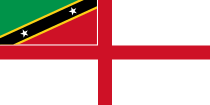
Back Vlag van St. Kitts en Nevis Afrikaans علم سانت كيتس ونيفيس Arabic علم سانت كيتس ونيفيس ARZ Сцяг Сент-Кітса і Невіса Byelorussian Национално знаме на Сейнт Китс и Невис Bulgarian সেন্ট কিট্স বারো নেভিসর ফিরালহান BPY Zastava Svetog Kristofora i Nevisa BS Bandera de Saint Christopher i Nevis Catalan Vlajka Svatého Kryštofa a Nevisu Czech Baner Sant Kitts-Nevis Welsh
 | |
| Use | National flag, civil and state ensign |
|---|---|
| Proportion | 2:3 |
| Adopted | 19 September 1983 |
| Design | A yellow-edged black diagonal band bearing two white five-pointed stars divided diagonally from the lower hoist-side corner to the upper fly-side corner: the upper triangle is green and the lower triangle is red. |
| Designed by | Edris Lewis |
| Naval ensign of Saint Kitts and Nevis | |
 | |
| Use | Naval ensign |
| Proportion | 1:2 |
| Design | A white field with a centered red cross, the national flag stretched out to a ratio of 1:2 is in the canton. |
| Flag of the governor-general of Saint Kitts and Nevis | |
 | |
| Proportion | 1:2 |
| Adopted | 19 September 1983 |
| Design | A lion statant guardant surmounted upon St Edward's Crown above a gold scroll inscribed with 'COUNTRY ABOVE SELF' on a blue field |

The flag of Saint Kitts and Nevis consists of a yellow-edged black band containing two white stars that divides diagonally from the lower hoist-side corner, with a green upper triangle and red lower triangle. Adopted in 1983 to replace the flag of Saint Christopher-Nevis-Anguilla, it has been the flag of the Federation of Saint Kitts and Nevis since the country gained independence that year. Although the flag utilises the colours of the Pan-Africanist movement, the symbolism behind them is interpreted differently.[1] The three islands later became part of the West Indies Federation in 1958; after this dissolved four years later, they were granted the status of associate state as Saint Christopher-Nevis-Anguilla.[2] However, Anguilla decided to secede from the federation in 1969,[3] owing to fears that their population, which was already small, would be further marginalised in parliament.[2] This was eventually formalised in 1980,[3] and a new flag for the remaining parts of the federation was needed, since the symbolism of the previous flag centred on the concept of a union of three.[2]
A national competition was held in the early 1980s to choose a new flag. The winning design by student Edris Lewis was one of 258 entries.[4] It was first hoisted one minute after midnight on 19 September 1983, the day Saint Kitts and Nevis became an independent country.[5][6]
- ^ Shaw, Carol P. (1992). Flags. HarperCollins UK. ISBN 0-00-470114-3.
- ^ a b c Smith, Whitney. "Saint Kitts and Nevis, flag of". Encyclopædia Britannica. Encyclopædia Britannica, Inc. Archived from the original on 4 December 2013. Retrieved 10 June 2013.(subscription required)
- ^ a b Olson, James Stuart; Shadle, Robert, eds. (1 January 1991). Historical Dictionary of European Imperialism. Greenwood Publishing Group. p. 28. ISBN 9780313262579. Retrieved 10 June 2013.
- ^ Kindersley, Dorling (3 November 2008). Complete Flags of the World. Dorling Kindersley Ltd. p. 33. ISBN 9781405333023. Retrieved 10 June 2013.
- ^ Hagman, Harvey (20 September 1983). "Newest Caribbean Flag Is Raised Over Tiny State Of St. Kitts–Nevis". The Miami Herald. Associated Press. p. 18A. Archived from the original on 5 March 2016. Retrieved 10 June 2013.(subscription required)
- ^ Sewell, Dan (19 September 1983). "St. Kitts–Nevis: New nation born". The Free Lance-Star. Fredericksburg. Associated Press. p. 4. Archived from the original on 6 December 2021. Retrieved 10 June 2013.
© MMXXIII Rich X Search. We shall prevail. All rights reserved. Rich X Search